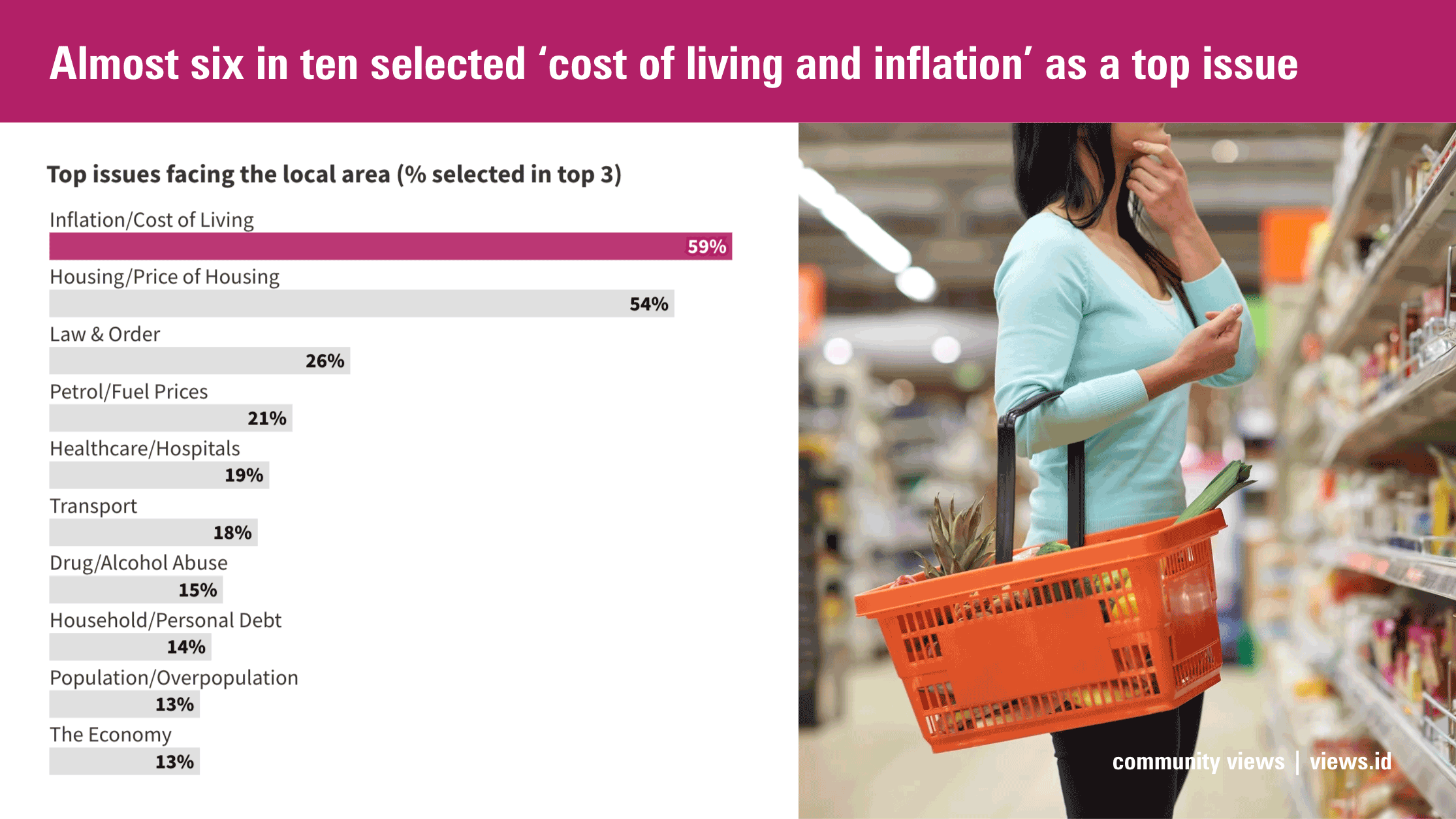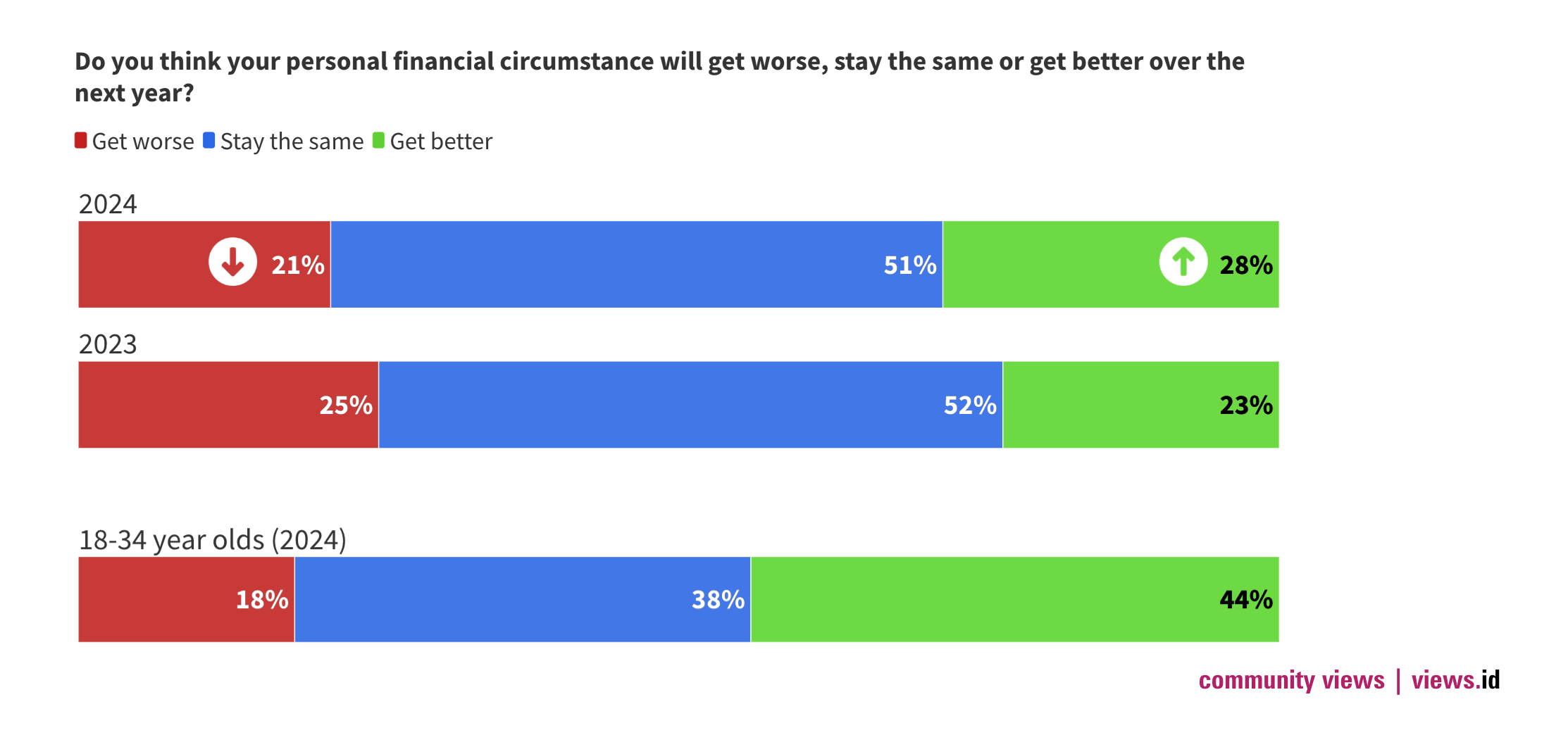The Living in Australia 2024: National Community Views Survey - Key Insights Report (DOWNLOAD HERE) draws on the views of the more than 5,000 people who participated in .id’s annual Living in Australia Community Views Survey collected across April and May 2024, and speaks to four themes we feel are critical to improving living standards across the nation.
As Australians continue to face the pressures of rising cost of living, it’s crucial to understand the ripple effects of these concerns, not just on spending habits but on broader aspects of life such as mental health, well-being, and community priorities. With a significant portion of the population grappling with inflation and financial insecurity, how individuals feel about the economy—and their own financial situation—can have far-reaching consequences on both their personal lives and on their communities.
Inflation/Cost of Living: The Top Concern for Australians
The Living in Australia study for 2024 revealed that when Australians were asked to identify the top issues facing their local area, the majority—59%—selected “cost of living and inflation” as one of their primary concerns.

This statistic has remained largely consistent since 2023, where 57% of Australians cited the same worry. It’s clear that rising prices continue to top the list of local issues, and this concern is felt across various corners of society.
A Generation Struggling Financially
While cost of living is a concern for all age groups, young Australians are experiencing this issue at higher rates. Two out of every three (68%) of 18 to 34 year-olds surveyed listed cost of living as a top issue in their local area, substantially higher than the one out-of-every two (48%) of 60+ year-olds who reported it as a concern.

This disparity can be attributed to the fact that younger people are generally in a more precarious financial position compared to their older counterparts. For many, the challenges of securing stable, well-paying jobs and navigating housing costs are compounded by broader economic pressures. On average, younger Australians rate their financial circumstances 5.4 out of 10, compared to 6.5 out of 10 for Australians aged 60 years or over.

Financial strain has been linked to lower levels of mental health. The data from Living in Australia 2024 shows a clear connection between financial struggles and poorer mental health. Among individuals who rated their financial circumstances as poor (0-3 out of 10), their self-reported mental health was significantly lower than the national average, at 5.3/10 compared to the national average of 7.2/10. This underscores the deeply personal impact that financial insecurity can have on well-being and mental health.

A Glimmer of Optimism Among Young Australians
Despite these challenges, there is some positive news. Australians, in general, were slightly more optimistic about their financial situation in the near future compared to last year. In fact, 28% of Australians at the time of the survey expected their financial circumstances to improve in the coming 12 months, an increase from 23% in 2023.

It is younger Australians who are the most optimistic, with 44% of individuals aged 18 to 34 expecting their financial situation to improve, showing that there is hope among this group despite the hardships they are facing.
This shift in mindset, though small, signals that there may be light at the end of the tunnel for many. It suggests that while financial difficulties persist, Australians—especially younger generations—believe that their situation could improve in the near future.
Changing Priorities: From Spending to Earning
As Australians navigate these financial challenges, their priorities are shifting. The focus on discretionary spending is starting to wane, particularly when it comes to activities like shopping, dining out, and leisure. Across Australia, the proportion of people who consider shopping, leisure, and dining as top attributes that make an area a good place to live has decreased from 31% to 28% between 2023 and 2024. This trend is particularly evident in both metropolitan and regional areas, as financial pressures take a more prominent role in shaping people’s priorities.

Interestingly, there has been a noticeable shift towards valuing “good job prospects.” The percentage of people ranking job opportunities as an important factor in choosing where to live has risen from 26% to 29%. This shift reflects a broader change in mindset from "How can I spend money?" to "How can I make more money?" It seems that, in response to financial pressures, Australians are prioritising stability and opportunities for growth rather than indulging in discretionary purchases.
Local-Level Insights for Economic and Social Policy
Understanding these trends is crucial for developing economic and social policies that are grounded in the realities of local communities. As cost pressures continue to impact everyday Australians, policymakers need to be aware of how these issues are impacting local life and residents’ priorities. Shifting from a mindset of consumption to one of economic opportunity suggests a need for increased focus on job creation, affordable housing, and financial security at the local level.
For younger Australians especially, addressing financial insecurity and improving mental health outcomes should be a priority. By understanding these challenges and adapting policies to meet the needs of a changing population, we can work towards creating communities that are not only financially stable but also resilient and ultimately thriving.
Learn more
If you’d like to learn more about how the Community Views Service helps a diverse and growing number of councils and other organisations credibly, comprehensively and efficiently represent and monitor their community’s views and needs in strategic planning and advocacy, our services page provides a simple overview, answers frequently asked questions and includes links to other helpful information.
Resources
Learn more about .id's Community Views Service, contact the team or book a free service overview.
Download the Living in Australia: 2024 National Liveability Survey report.
Explore our Living in Australia National Liveability survey results on the views.id platform HERE.
See how Councils are using Community Views insights and data to represent resident priorities in decision making: Ipswich City Council, Banyule City Council, Sunshine Coast Regional Council and City of Canning.















